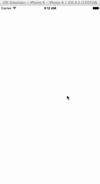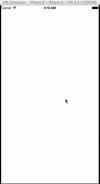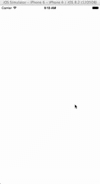UICollectionView Horizontal Paging not centered
IosUiscrollviewUicollectionviewIos Problem Overview
I have a horizontal scrolling collectionView with each cell the size of the view. When I page through the collectionView it doesn't page by cell. The cells aren't in the center of the screen. I've tried a bunch of things to try to fix it and haven't had any luck. Here's a video of the problem: https://www.youtube.com/watch?v=tXsxWelk16w Any ideas?
Ios Solutions
Solution 1 - Ios
Remove spaces between items. For horizontal scrolling collection view set minimum line spacing to 0. You can do this with interface builder or with method of UICollectionViewDelegateFlowLayout protocol:
- (CGFloat)collectionView:(UICollectionView *)collectionView
layout:(UICollectionViewLayout *)collectionViewLayout
minimumLineSpacingForSectionAtIndex:(NSInteger)section {
return 0;
}

Another way is making your cell's width less than collectionView's width for a value of horizontal space between items. Then add section insets with left and right insets that equal a half of horizontal space between items. For example, your minimum line spacing is 10:
- (CGFloat)collectionView:(UICollectionView *)collectionView
layout:(UICollectionViewLayout *)collectionViewLayout
minimumLineSpacingForSectionAtIndex:(NSInteger)section {
return 10;
}
- (CGSize)collectionView:(UICollectionView *)collectionView
layout:(UICollectionViewLayout *)collectionViewLayout
sizeForItemAtIndexPath:(NSIndexPath *)indexPath {
return CGSizeMake(collectionView.frame.size.width - 10, collectionView.frame.size.height);
}
- (UIEdgeInsets)collectionView:(UICollectionView *)collectionView
layout:(UICollectionViewLayout *)collectionViewLayout
insetForSectionAtIndex:(NSInteger)section {
return UIEdgeInsetsMake(0, 5, 0, 5);
}

And third way: manipulate collectionView scroll in scrollViewDidEndDecelerating: method:
- (void)scrollViewDidEndDecelerating:(UIScrollView *)scrollView {
if (scrollView == self.collectionView) {
CGPoint currentCellOffset = self.collectionView.contentOffset;
currentCellOffset.x += self.collectionView.frame.size.width / 2;
NSIndexPath *indexPath = [self.collectionView indexPathForItemAtPoint:currentCellOffset];
[self.collectionView scrollToItemAtIndexPath:indexPath
atScrollPosition:UICollectionViewScrollPositionCenteredHorizontally
animated:YES];
}
}

Solution 2 - Ios
Demo here in Swift 3: https://github.com/damienromito/CollectionViewCustom
func scrollViewWillEndDragging(_ scrollView: UIScrollView, withVelocity velocity: CGPoint, targetContentOffset: UnsafeMutablePointer<CGPoint>) {
let pageWidth = Float(itemWidth + itemSpacing)
let targetXContentOffset = Float(targetContentOffset.pointee.x)
let contentWidth = Float(collectionView!.contentSize.width )
var newPage = Float(self.pageControl.currentPage)
if velocity.x == 0 {
newPage = floor( (targetXContentOffset - Float(pageWidth) / 2) / Float(pageWidth)) + 1.0
} else {
newPage = Float(velocity.x > 0 ? self.pageControl.currentPage + 1 : self.pageControl.currentPage - 1)
if newPage < 0 {
newPage = 0
}
if (newPage > contentWidth / pageWidth) {
newPage = ceil(contentWidth / pageWidth) - 1.0
}
}
self.pageControl.currentPage = Int(newPage)
let point = CGPoint (x: CGFloat(newPage * pageWidth), y: targetContentOffset.pointee.y)
targetContentOffset.pointee = point
}
Swift 4:
func scrollViewWillEndDragging(_ scrollView: UIScrollView, withVelocity velocity: CGPoint, targetContentOffset: UnsafeMutablePointer<CGPoint>) {
let pageWidth = Float(itemWidth + itemSpacing)
let targetXContentOffset = Float(targetContentOffset.pointee.x)
let contentWidth = Float(collectionView!.contentSize.width )
var newPage = Float(self.pageControl.currentPage)
if velocity.x == 0 {
newPage = floor( (targetXContentOffset - Float(pageWidth) / 2) / Float(pageWidth)) + 1.0
} else {
newPage = Float(velocity.x > 0 ? self.pageControl.currentPage + 1 : self.pageControl.currentPage - 1)
if newPage < 0 {
newPage = 0
}
if (newPage > contentWidth / pageWidth) {
newPage = ceil(contentWidth / pageWidth) - 1.0
}
}
self.pageControl.currentPage = Int(newPage)
let point = CGPoint (x: CGFloat(newPage * pageWidth), y: targetContentOffset.pointee.y)
targetContentOffset.pointee = point
}
Solution 3 - Ios
Swift version of @vlad-che accepted answer:
extension GoodsViewController: UICollectionViewDelegateFlowLayout {
func collectionView(_ collectionView: UICollectionView, layout collectionViewLayout: UICollectionViewLayout, minimumLineSpacingForSectionAt section: Int) -> CGFloat {
return 10
}
func collectionView(_ collectionView: UICollectionView, layout collectionViewLayout: UICollectionViewLayout, sizeForItemAt indexPath: IndexPath) -> CGSize {
let frameSize = collectionView.frame.size
return CGSize(width: frameSize.width - 10, height: frameSize.height)
}
func collectionView(_ collectionView: UICollectionView, layout collectionViewLayout: UICollectionViewLayout, insetForSectionAt section: Int) -> UIEdgeInsets {
return UIEdgeInsets(top: 0, left: 5, bottom: 0, right: 5)
}
}
Solution 4 - Ios
Swift 4 solution to remove line spacing to keep cells centered:
public func collectionView(_ collectionView: UICollectionView, layout
collectionViewLayout: UICollectionViewLayout,
minimumLineSpacingForSectionAt section: Int) -> CGFloat {
return 0
}
Solution 5 - Ios
Swift 3
func scrollViewDidEndDecelerating(_ scrollView: UIScrollView) {
if scrollView == self.collectionView {
var currentCellOffset = self.collectionView.contentOffset
currentCellOffset.x += self.collectionView.frame.width / 2
if let indexPath = self.collectionView.indexPathForItem(at: currentCellOffset) {
self.collectionView.scrollToItem(at: indexPath, at: .centeredHorizontally, animated: true)
}
}
}
Solution 6 - Ios
Being able to have cells that are smaller the collectionView frame with space between the cells allows for hinting to the user that there other cells either side to scroll to which is a big win for UX. But for the centering of the pages doesn't work as expected with each cell progressively becoming more offset as the user scrolls. I've found the following to work well. The centering/snapping animation on each cell is almost invisible to user since it is only tweaking where the collectionView scrolling would end naturally rather than jerking the collectionView to quickly scroll to another indexPath. It's still important to to have the sectionInset property set large enough to allow cell not to stick to the containing frame edges. Also since there are spaces between the cells the target could land on an indexPath of nil which would cause the collectionView to scroll back to the start. I've fixed this offsetting a little and then trying again but different approaches could be taken here.
- (void)scrollViewWillEndDragging:(UIScrollView *)scrollView
withVelocity:(CGPoint)velocity
targetContentOffset:(inout CGPoint *)targetContentOffset
{
//Ensure the scrollview is the collectionview we care about
if (scrollView == self.collectionView) {
// Find cell closest to the frame centre with reference from the targetContentOffset.
CGPoint frameCentre = self.collectionView.center;
CGPoint targetOffsetToCentre = CGPointMake((* targetContentOffset).x + frameCentre.x, (* targetContentOffset).y + frameCentre.y);
NSIndexPath *indexPath = [self.collectionView indexPathForItemAtPoint:targetOffsetToCentre];
//Check for "edgecase" that the target will land between cells and then find a close neighbour to prevent scrolling to index {0,0}.
while (!indexPath) {
targetOffsetToCentre.x += ((UICollectionViewFlowLayout *)self.collectionView.collectionViewLayout).minimumInteritemSpacing;
indexPath = [self.collectionView indexPathForItemAtPoint:targetOffsetToCentre];
}
// Find the centre of the target cell
CGPoint centreCellPoint = [self.collectionView layoutAttributesForItemAtIndexPath:indexPath].center;
// Calculate the desired scrollview offset with reference to desired target cell centre.
CGPoint desiredOffset = CGPointMake(centreCellPoint.x - frameCentre.x, centreCellPoint.y - frameCentre.y);
*targetContentOffset = desiredOffset;
}
}
Solution 7 - Ios
If you're after the behaviour of collectionView.isPagingEnabled (so with 'proper inertia feeling' etc) but without wrong offsets when setting a contentInset or spacing, this is what you need:
func scrollViewWillEndDragging(_ scrollView: UIScrollView, withVelocity velocity: CGPoint, targetContentOffset: UnsafeMutablePointer<CGPoint>) {
let itemWidth = cellSize.width + spacing
let inertialTargetX = targetContentOffset.pointee.x
let offsetFromPreviousPage = (inertialTargetX + collectionView.contentInset.left).truncatingRemainder(dividingBy: itemWidth)
// snap to the nearest page
let pagedX: CGFloat
if offsetFromPreviousPage > itemWidth / 2 {
pagedX = inertialTargetX + (itemWidth - offsetFromPreviousPage)
} else {
pagedX = inertialTargetX - offsetFromPreviousPage
}
let point = CGPoint(x: pagedX, y: targetContentOffset.pointee.y)
targetContentOffset.pointee = point
}
Solution 8 - Ios
Swift 3.0 set your own UICollectionViewFlowLayout
let layout: UICollectionViewFlowLayout = UICollectionViewFlowLayout()
let width = UIScreen.main.bounds.width
layout.itemSize = CGSize(width: width, height: 154)
layout.sectionInset = UIEdgeInsets(top: 0, left: 0, bottom: 0, right: 0)
layout.minimumInteritemSpacing = 0
layout.minimumLineSpacing = 0
layout.scrollDirection = .horizontal
collectionView?.collectionViewLayout = layout
Solution 9 - Ios
After having a similar issue, I fixed mine by realizing that when using horizontal scrolling the height is now the width and the width is now the height because the default is set for vertical scrolling. Try switching the values and see if that helps. https://developer.apple.com/library/content/documentation/WindowsViews/Conceptual/CollectionViewPGforIOS/UsingtheFlowLayout/UsingtheFlowLayout.html
Solution 10 - Ios
The code I just saw from Apple Official Guides and Sample Code:
> AssetViewController.swift:
self.collectionView?.isPagingEnabled = true
self.collectionView?.frame = view.frame.insetBy(dx: -20.0, dy: 0.0)
this code enlarges the collection view so that it extends out of the screen, while the content is just within the screen edges
Solution 11 - Ios
The problem here is that isPagingEnabled doesn't consider the contentSize, but rather the collection bounds: > the scroll view stops on multiples of the scroll view’s bounds when the user scrolls.
To achieve what we want, we need to calculate the next offset ourselves and turn off isPagingEnabled.
As you can see in the image above, the second cell should start at:
One side + Cell - Next cell visible part.
Here's a delegate that calculates just that: https://gist.github.com/danielCarlosCE/7a5f80dc6087773ba147be4dc72da826
Solution 12 - Ios
Swift 3 solution based on @Santos's answer, for use if if you have a regular horizontally paging collection view without a page control like Paolo was using in his Swift 3 example.
I used this to solve an issue where a horizontally paging cell full screen cells with a custom UICollectionViewFlowLayout animator didn't finish rotating AND ended up offset so that the the edges of a full screen cell frame were increasingly horizontally off set from the collection view's bounds as you scrolled (like in the video OP shared).
func scrollViewWillEndDragging(_ scrollView: UIScrollView, withVelocity velocity: CGPoint, targetContentOffset: UnsafeMutablePointer<CGPoint>) {
// Ensure the scrollview is the one on the collectionView we care are working with
if (scrollView == self.collectionView) {
// Find cell closest to the frame centre with reference from the targetContentOffset.
let frameCenter: CGPoint = self.collectionView.center
var targetOffsetToCenter: CGPoint = CGPoint(x: targetContentOffset.pointee.x + frameCenter.x, y: targetContentOffset.pointee.y + frameCenter.y)
var indexPath: IndexPath? = self.collectionView.indexPathForItem(at: targetOffsetToCenter)
// Check for "edge case" where the target will land right between cells and then next neighbor to prevent scrolling to index {0,0}.
while indexPath == nil {
targetOffsetToCenter.x += 10
indexPath = self.collectionView.indexPathForItem(at: targetOffsetToCenter)
}
// safe unwrap to make sure we found a valid index path
if let index = indexPath {
// Find the centre of the target cell
if let centerCellPoint: CGPoint = collectionView.layoutAttributesForItem(at: index)?.center {
// Calculate the desired scrollview offset with reference to desired target cell centre.
let desiredOffset: CGPoint = CGPoint(x: centerCellPoint.x - frameCenter.x, y: centerCellPoint.y - frameCenter.y)
targetContentOffset.pointee = desiredOffset
}
}
}
}
Solution 13 - Ios
Add Collection View To The Full Screen and Remove Spacing Between Cells and Estimated Size Will be None
add This Collection View Delegate Method
func collectionView(_ collectionView: UICollectionView, layout collectionViewLayout: UICollectionViewLayout, sizeForItemAt indexPath: IndexPath) -> CGSize { return CGSize(width: collectionView.frame.width, height: collectionView.frame.height) }

